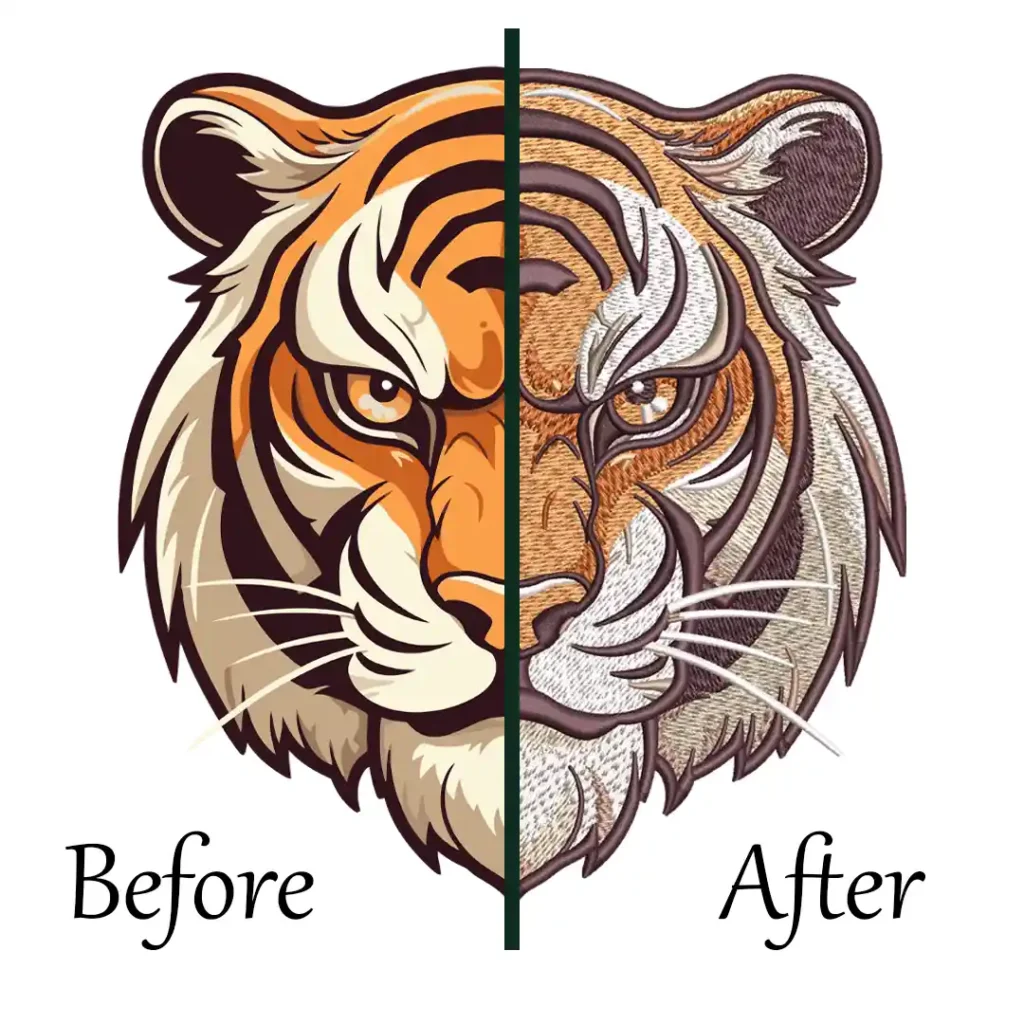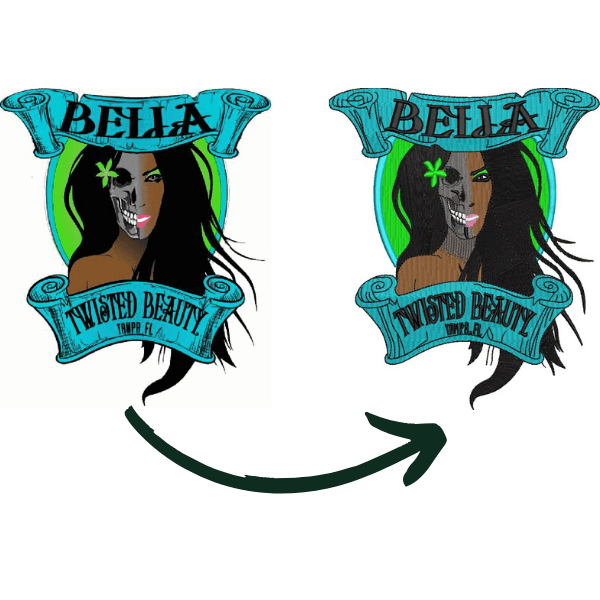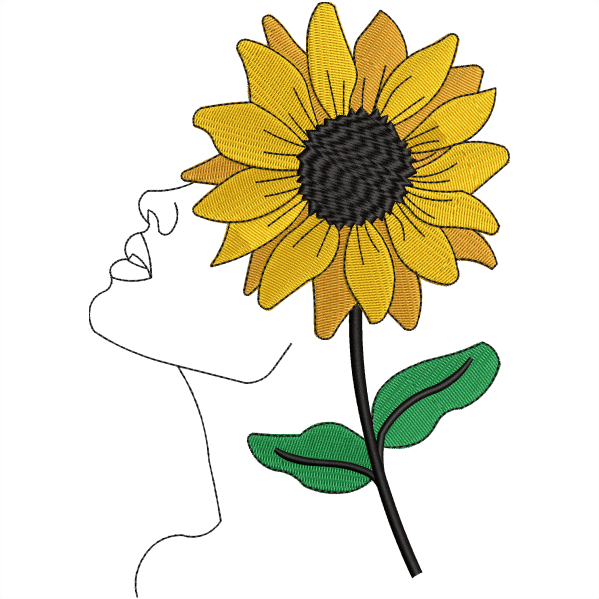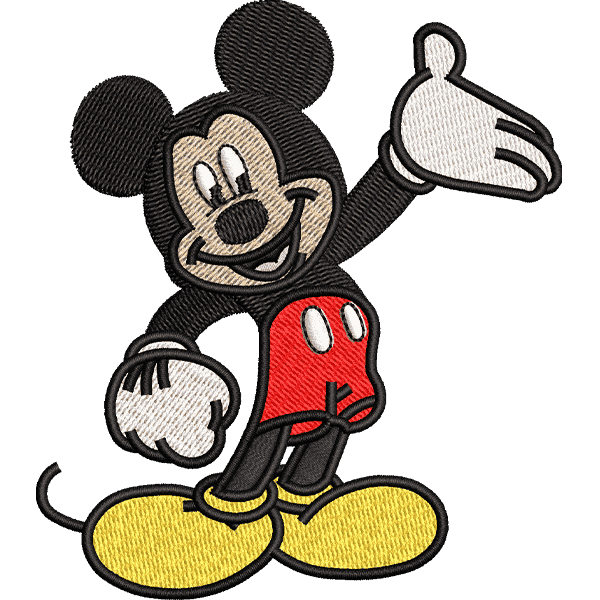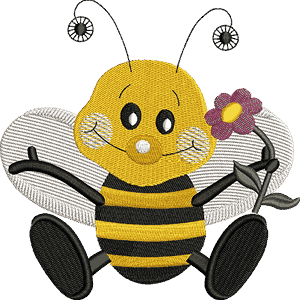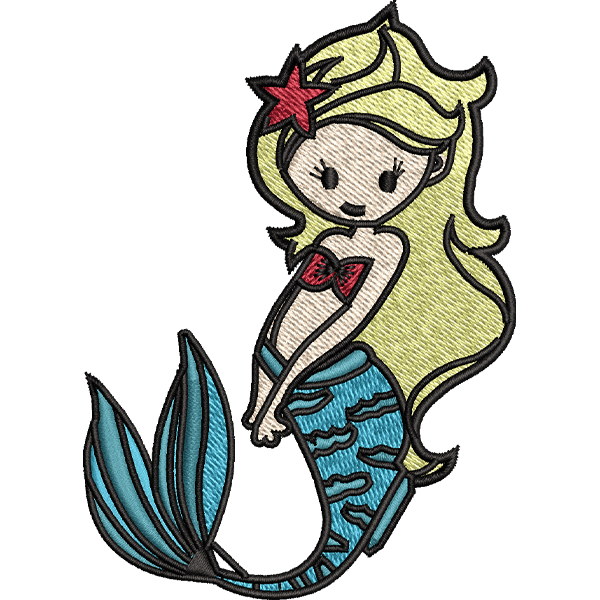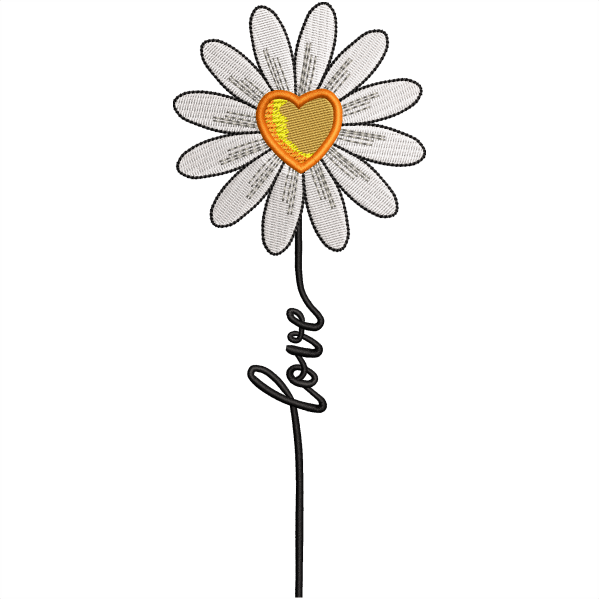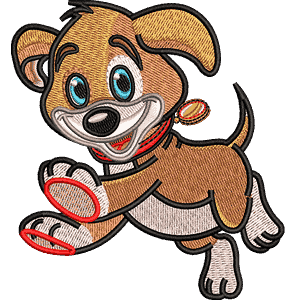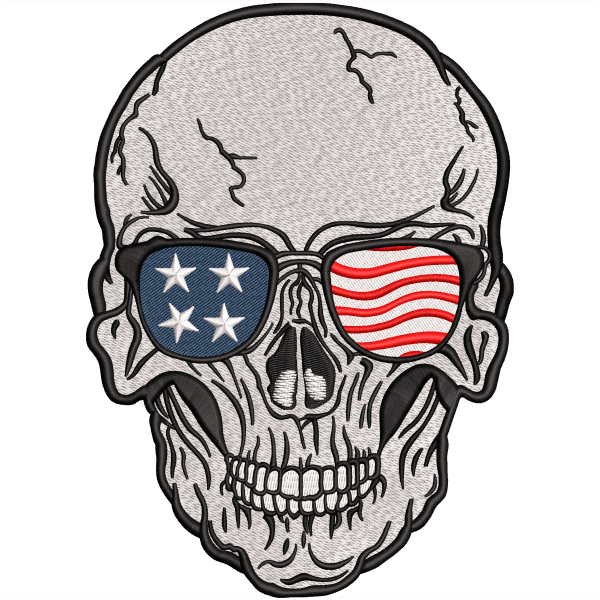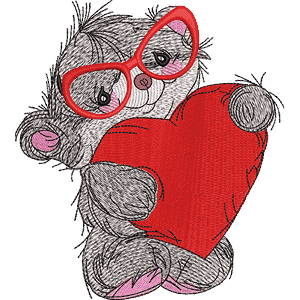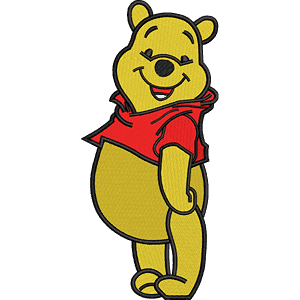Color theory plays an important role in creating beautiful and eye-catching embroidery designs. Understanding how colors work together helps you choose the right thread combinations and make your designs stand out. If you’re new to machine embroidery, learning a few basics of color theory can instantly improve your projects.
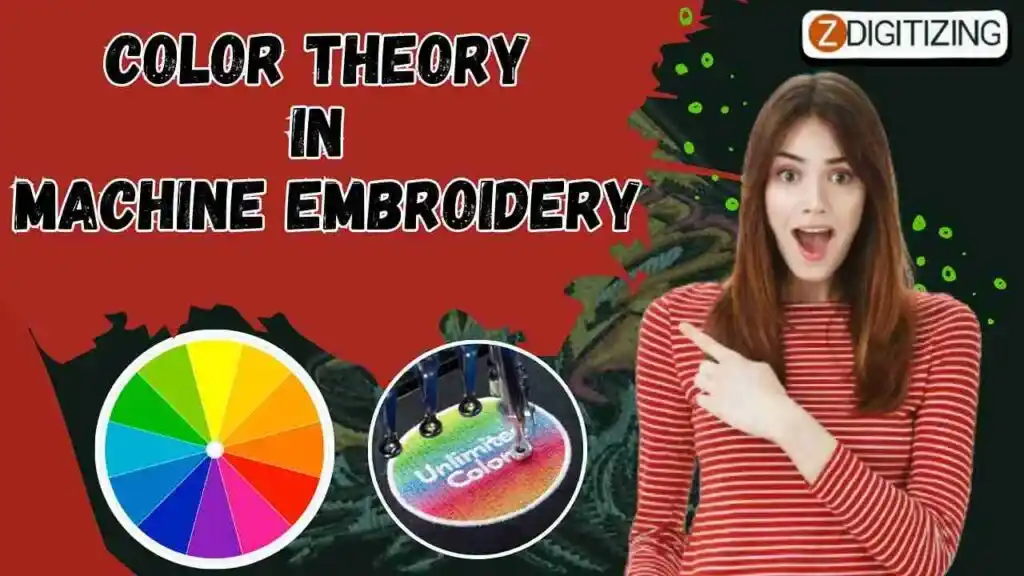
In this guide, we’ll walk you through the key concepts of color theory, from choosing complementary colors to creating harmony in your designs. Let’s dive into the world of color and start enhancing your embroidery projects!
Beginner’s Guide to Color Theory in Machine Embroidery
Essential Color Terminology for Embroiderers
Understanding color terminology is important when applying machine embroidery color theory, as it helps you select and use colors effectively in your designs. Here’s a breakdown of key terms:
- Hue: Hue refers to the pure color you see, such as red, blue, or green. It shows the color’s position on the color wheel.
- Tone: A tone is created when gray is added to a color, making it less intense. It softens the brightness of the original hue.
- Shade: A shade is made when black is added to a color, making it darker. For example, adding black to red creates a dark red shade.
- Tint: A tint happens when white is added to a color, making it lighter. For instance, pink is a tint of red.
- Saturation: Saturation shows how vivid or intense a color is. Bright colors are highly saturated, while faded colors are less saturated.
- Primary Colors: These are the three main colors—red, blue, and yellow. You cannot create them by mixing other colors.
- Secondary Colors: When you mix two primary colors, you get secondary colors. For example, mixing red and blue creates purple.
- Tertiary Colors: These colors are made by mixing a primary color with a secondary color. For example, mixing blue and green creates blue-green.
- Pantone Color Chart: This is a standardized color chart used in industries like embroidery and printing. It helps ensure that the exact same color is used across different projects.
Embroidery Digitizing & Vector Art Services
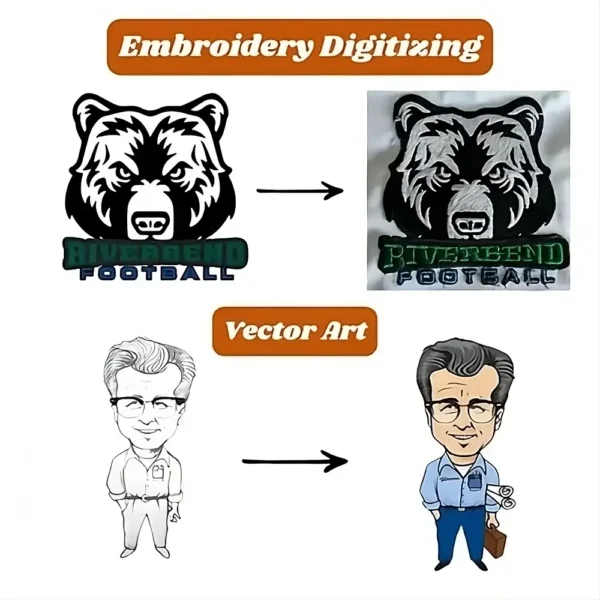
Looking for embroidery digitizing and vector art services that are affordable and reliable? We offer fast turnaround time, guaranteed quality, and the option to preview your design before payment, we make sure you get exactly what you need. Your satisfaction is our top priority, and we’re dedicated to delivering the best results. Don’t wait—try ZDigitizing today and see the difference in quality and service!
Embroidery Digitizing & Vector Art Services
Looking for embroidery digitizing and vector art services that are affordable and reliable? We offer fast turnaround time, guaranteed quality, and the option to preview your design before payment, we make sure you get exactly what you need. Your satisfaction is our top priority, and we’re dedicated to delivering the best results. Don’t wait—try ZDigitizing today and see the difference in quality and service!
Use of Color Wheel in Machine Embroidery
The embroidery color wheel is a vital tool that helps embroiderers understand the relationships between colors. By mastering how colors interact, you can create visually appealing and harmonious designs in machine embroidery.
Primary, Secondary, and Tertiary Colors
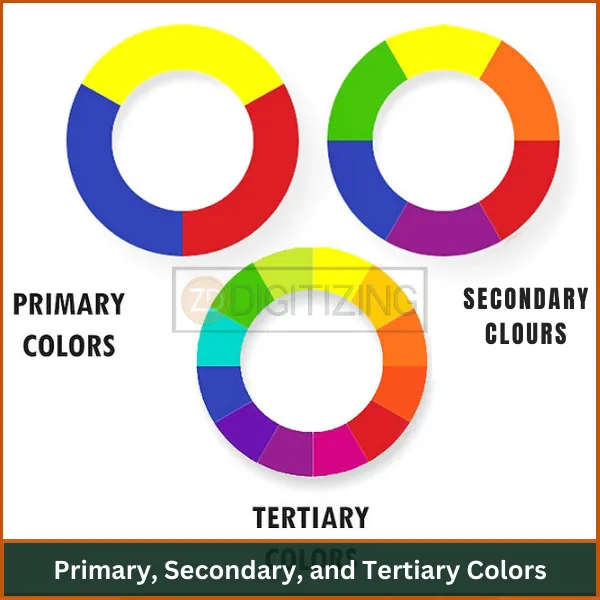
The color wheel consists of three primary colors (red, yellow, blue), three secondary colors (orange, green, purple), and six tertiary colors (yellow-orange, red-orange, red-violet, blue-violet, blue-green, yellow-green). Understanding these relationships is crucial for embroidery thread color selection in embroidery projects.
Complementary Colors
Complementary colors are those that sit opposite each other on the color wheel, like red and green or blue and orange. Using complementary colors adds high contrast and creates a visually striking design, making your work stand out.
Analogous Colors
Analogous colors sit next to each other on the color wheel, such as blue, blue-green, and green. These color combinations create a more cohesive and harmonious look, often found in nature, giving your embroidery designs a soothing and calming effect. This approach is often used for harmonizing thread colors to make designs flow naturally.
Triadic Colors
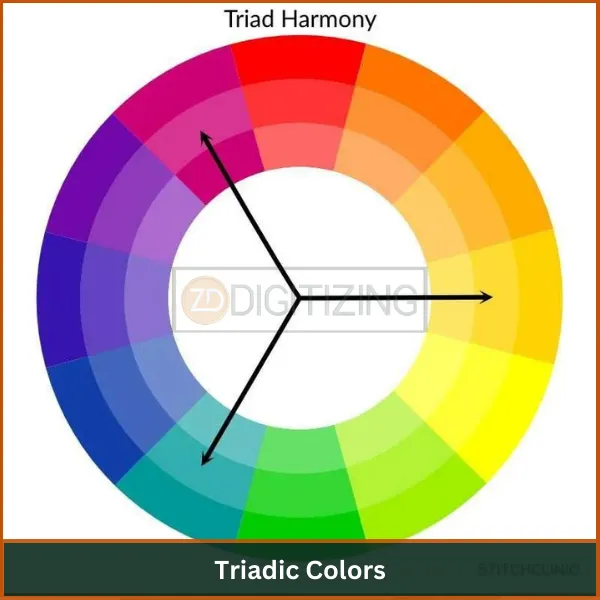
Triadic colors are evenly spaced around the color wheel, like red, yellow, and blue. These colors provide a vibrant and dynamic contrast, making them ideal for designs that need to pop without overwhelming the viewer.
Value and Saturation in Embroidery
Value refers to how light or dark a color is, while saturation shows the intensity or brightness of the color. Adjusting value and saturation in your thread choices can bring depth and dimension to your embroidery work, enhancing the overall look.
Psychological Impact of Colors in Embroidery
Colors have a powerful effect on our emotions, mood, and perception. When planning your machine embroidery designs, it’s essential to understand how different colors can influence the viewer’s reaction.
Let’s explore key factors to consider when selecting your color palette.
Warm vs. Cool Colors
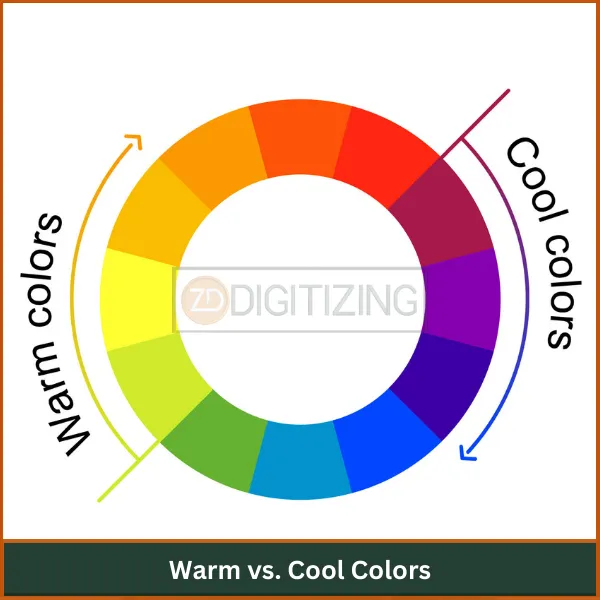
Warm colors like red, orange, and yellow evoke feelings of energy, passion, and excitement. They tend to make designs feel vibrant and attention-grabbing.
On the other hand, cool colors like blue, green, and purple create a calming, serene effect, making designs appear more peaceful and soothing. This contrast between warm and cool tones is a core part of machine stitching and color harmony.
Bright vs. Muted Colors
Bright, saturated colors like neon yellow or hot pink are visually stimulating and grab attention, giving your embroidery an energetic feel. Muted colors, such as dusty rose or sage green, create a more subtle and sophisticated design. They bring a calming effect and are often associated with understated elegance.
Color Associations
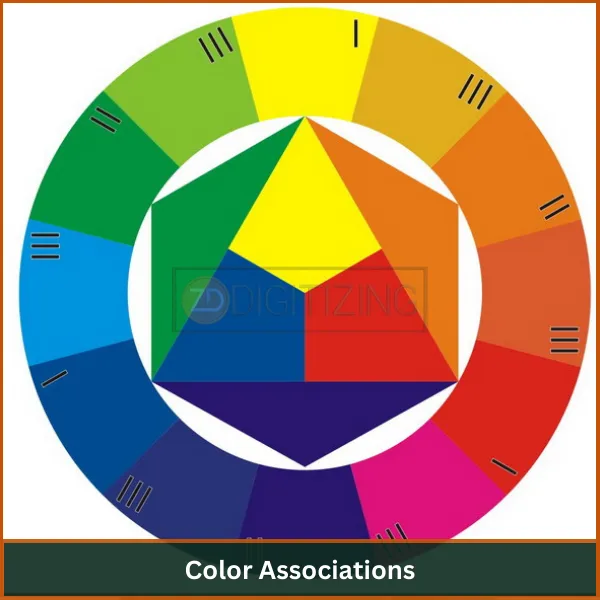
Each color carries associations that can enhance the theme of your embroidery design. For example, red is often linked to love, power, and danger, while blue is seen as a symbol of trust, stability, and intelligence. Green is associated with nature, growth, and wealth.
Leveraging color psychology in embroidery helps you align your design’s message with the emotions these colors evoke.
Symbolism and Culture
Colors can carry different meanings in various cultures. In many Western societies, white symbolizes purity and innocence, whereas in some Eastern cultures, it is associated with mourning. Understanding these cultural differences allows you to choose colors that resonate with your audience and ensure the correct interpretation of your design.
Emotional Impact
Colors directly impact how we feel. For instance, blue is calming, while red can evoke excitement or even anger. Using colors that align with the emotional tone of your design ensures that the embroidery leaves a lasting impression.
Using Contrast and Value in Embroidery Designs
In machine embroidery, understanding color theory, including contrast and value, is crucial for creating visually appealing and dynamic designs. Proper use of these elements can make your work stand out and give depth to your embroidery.
Contrast in Embroidery
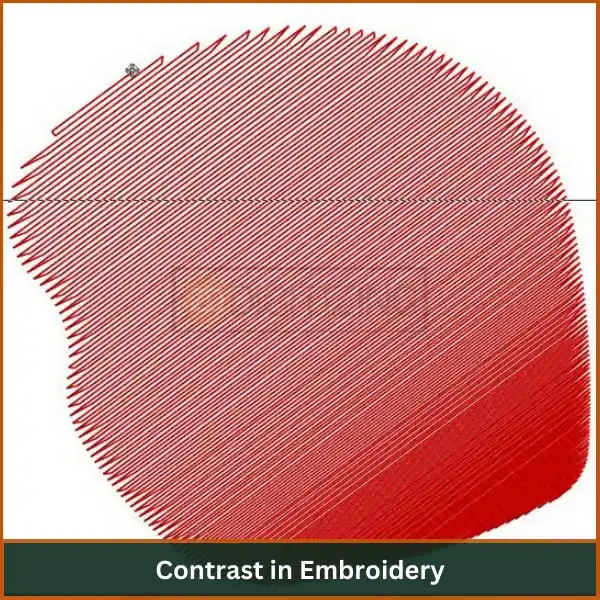
Contrast and complementary colors play an important role in design. Contrast refers to the difference between two colors or elements in a design.
High contrast, such as pairing black with white, draws attention and creates a bold look. Low contrast, like using two shades of the same color, provides a subtle and blended appearance.
- High Contrast: Ideal for making specific elements of a design stand out. For example, using contrasting thread colors, like red and green, can create a striking visual effect.
- Low Contrast: Suitable for softer, more harmonious designs. This approach is perfect for creating depth without making the design too bold or overwhelming.
Value in Embroidery
Value refers to the lightness or darkness of a color. By varying the value of your thread colors, you can add dimension to your embroidery design.
- Light Values: Colors with more white in them, such as light blue or pale pink, tend to appear softer and create a sense of openness.
- Dark Values: Colors with more black, like navy blue or dark green, can add weight and a sense of depth to your designs.
Using value effectively can help highlight certain parts of a design or create shadow effects that add a three-dimensional feel.
Combining Contrast and Value for Impact
Combining contrast and value can make your embroidery designs more engaging. For example, using a dark value thread on a light fabric creates a high contrast, making the design pop. Conversely, using threads of similar values creates a smoother, more integrated look.
Color Blending In Embroidery Digitizing
Color blending is a crucial technique in embroidery digitizing that adds depth, dimension, and realism to your designs. By combining different shades and hues, you can create smooth transitions between colors, giving your embroidery a more dynamic and lifelike appearance.
What is Color Blending in Embroidery?
Color blending involves mixing two or more colors to create a gradient or seamless transition between different areas of a design. This technique is often used in complex designs, such as landscapes or images with shading, to make the design appear more realistic and visually appealing.
Thread Color Blending Techniques
There are several thread color blending techniques used in embroidery digitizing to achieve the desired effect:
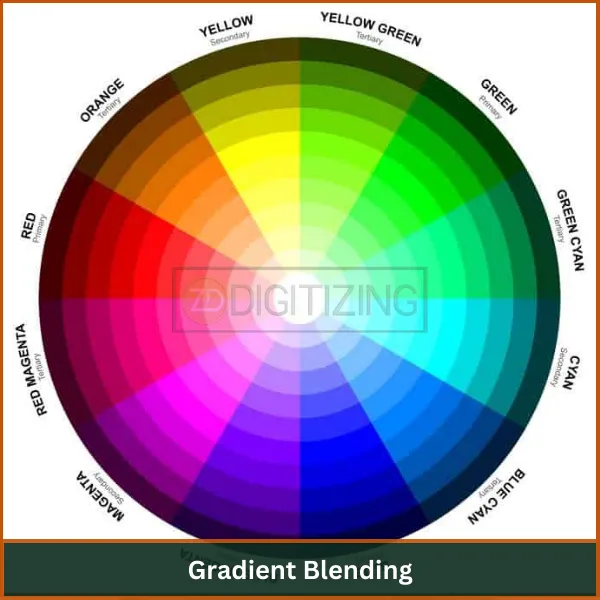
Gradient Blending: This technique involves gradually transitioning from one color to another. For instance, moving from a light blue to a dark blue can create a natural sky effect.
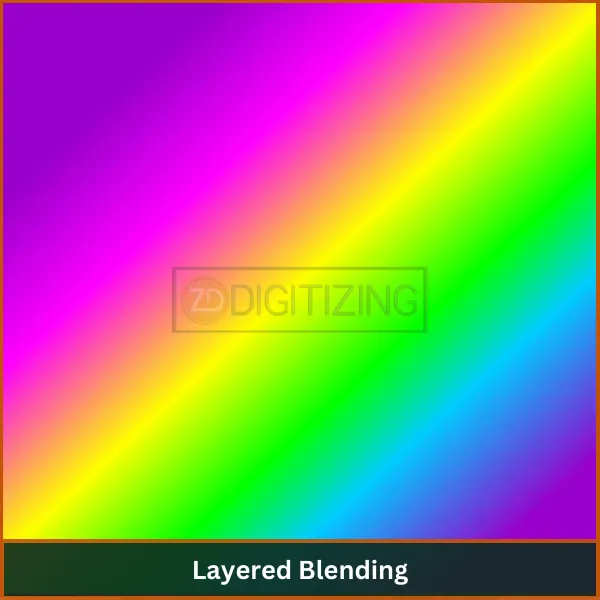
Layered Blending: In this method, layers of different colors are stitched over each other to produce a gradual blending effect. This works well for designs that require subtle color shifts, like animal fur or floral patterns.
Cross-Stitch Blending: Cross-stitching two different colors together can create an intricate blend, especially when working with fine details. It’s commonly used in designs that require more texture.
Benefits of Color Blending in Embroidery Digitizing
- Realism: By using color blending, designs can mimic real-life textures, shadows, and highlights, making them look more professional.
- Depth and Dimension: Blended colors create the illusion of depth in flat embroidery, giving a 3D effect to designs.
- Versatility: This technique can be applied to various design types, from portraits to intricate logos, enhancing the overall visual impact.
Tips for Effective Color Blending
- Use Complementary Colors: When blending, choosing complementary or analogous colors helps create smooth transitions.
- Control the Stitch Density: Adjusting stitch density can affect how well the colors blend, with denser stitches creating a smoother transition.
Applications of Color Theory in Embroidery Projects
Understanding the theory of colors helps embroiderers create visually appealing designs. Here are some practical applications:
- Choosing Harmonious Colors: Use the color wheel to select complementary or analogous colors for balanced designs.
- Creating Contrast: Apply contrasting colors to make elements stand out, adding visual interest to your work.
- Setting the Mood: Warm colors evoke energy, while cool tones provide a calming effect, helping you control the emotional response to your design.
- Enhancing Depth: Blending light and dark values adds dimension to flat designs, making them more dynamic and realistic.
- Brand Identity: Consistent use of specific colors helps reinforce brand identity in logo and uniform embroidery.
Embroidery Digitizing & Vector Art Services

Looking for embroidery digitizing and vector art services that are affordable and reliable? We offer fast turnaround time, guaranteed quality, and the option to preview your design before payment, we make sure you get exactly what you need. Your satisfaction is our top priority, and we’re dedicated to delivering the best results. Don’t wait—try ZDigitizing today and see the difference in quality and service!
Embroidery Digitizing & Vector Art Services
Looking for embroidery digitizing and vector art services that are affordable and reliable? We offer fast turnaround time, guaranteed quality, and the option to preview your design before payment, we make sure you get exactly what you need. Your satisfaction is our top priority, and we’re dedicated to delivering the best results. Don’t wait—try ZDigitizing today and see the difference in quality and service!
Conclusion
Learning color theory in machine embroidery can really help make your designs look better and more professional. By using the right color combinations, contrast, and harmony, you can create embroidery that stands out and looks amazing.
Whether you’re just starting or have experience, knowing how to work with colors will make a big difference in your projects.
At ZDigitizing, we’re here to help with your embroidery needs. We offer fast turnaround, affordable prices, and high-quality digitizing services to make sure your designs look great. Plus, new customers get 50% off their first order.
Let us handle your digitizing so you can focus on creating beautiful embroidery!
FAQs
There are 3 basic color theories: color harmony, color wheel, and color context (how colors are used). They are used to create logical color structures.
The fabric color also affects the color combination you choose:
- Use the color wheel to select a color.
- Look at your surroundings, you’ll find a lot of color combinations.
- You can trust your experience. When you think about any designs most color combination comes to mind.
Colors are used to add depth and detail to embroidery design. When you’re creating 3D design placement of color is important. You can use a combination of light and dark colors to add dimension and depth to your design.
It is a study through which you can understand how color combinations look and how they affect consumer perception and emotions. It is like a game-changer tool for designers, artists, and embroidery creators because it helps them choose the right color for their embroidery projects.
According to the psychology of colors, it has a strong impact on humans. Because color combinations can influence our buying decisions. Also, color hues raise our emotional reaction.

